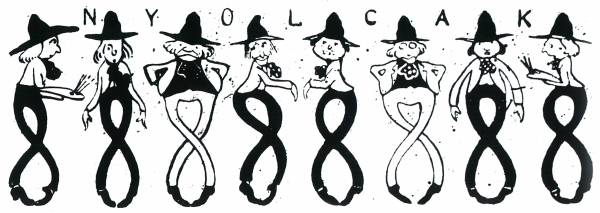Two Exhibitions – Without Architecture
Under the Spell of Cézanne and Matisse – the Group of the Eight Centenary exhibition, Pécs 10. 12. 2010. – 27. 03. 2011.

Karikatúra a Fidibuszban, 1909
The members of the Group of the Eight (Róbert Berény, Dezső Czigány, Béla Czóbel, Károly Kernstok, Ödön Márffy, Dezső Orbán, Bertalan Pór, and Lajos Tihanyi) created their own painting style mostly under the spell of modern French art.
Their exhibition organised in 1909 was a turning point in the history of Hungarian art: for the first time a young group of artists appeared on the scene whose work organically matched the most modern international trends. The members of the Eight were inspired by Fauvism, mostly by the work of Cézanne, apart from Matisse. Gradually, they turned to a kind of neoclassic monumentality from early pictorial solutions involving the use of dissolved, strong colours. They only had three exhibitions at that time, which were accompanied by high-quality cultural programmes with the contribution of artists and scholars such as Endre Ady, Béla Bartók, Zoltán Kodály and György Lukács.
The exhibition in Pécs is an attempt to recreate the three former exhibitions in Budapest, complemented with a representative collection of works by the members around 1910. An important aim of the exhibition is to integrate the art of the Eight into the modern trends of contemporary Europe. This aim is served by the presentation of an international collection of works showing the visual sources that inspired the work of the Eight – primarily the works of Cézanne, but also including similar efforts by foreign contemporaries such as Matisse, Picasso, Dufy, Vlaminck, and Kokoschka. Just like one hundred years ago, the exhibition also features literary and music programmes where the finest Hungarian artists revive the milieu of the beginning of the last century. As part of the exhibition, a scholarly catalogue in English and Hungarian will be published, introducing not only the artistic activities of the group of the Eight but also their intellectual background, theoretical and philosophical views as well as their literary and musical relationships.
XIX. Art and Nation: Image and Self-Image, Hungarian National Gallery, 05. 11. 2010. – 03. 03. 2011.
The exhibition offers a pictorial testimony to the relationship between art and the concept of the nation from the end of the 18th century to the First World War. This period-called the “long century”-was a time when the bourgeoisie had established itself and nation-building and national self-definition were at their height. The efforts to establish an autonomous national school of art and its institutions were motivated by the desire to catch up with Western European culture. In the early 19th century, Hungarian sculptors and painters were intent on capturing national characteristics in their work, giving rise to a new kind of representational painting. While these artists were well versed in the conceptual frameworks taught in European art academies, they drew their inspiration from Hungarian history; aspiring to depict the nation’s past, they created images of national glory and sacrifice and frequently rendered historical monuments in landscapes. This kind of subject matter was not inimical to the preferences of the gallery-goer of the time; it elicited a feeling of identification while kindling a sense of “belonging”. The great plain and the image of its characteristic shadoof well became symbols of the Hungarian landscape, and paintings of the period customarily depicted the Hungarian people as either revelling in good cheer or afflicted with grief. Pictorial representations of a modernising Budapest were a reminder of the nation’s progress on the one hand, and on the other poignantly called to mind the tensions generated by growing societal polarization. At the turn of the century, modern Western trends were prominent among Hungarian painters, though many Naturalist, plein air and Post-Impressionist painters still considered it their duty to memorialize Hungarian culture. Traditional themes and motifs continued to survive to a degree, with works of art expressing the national selfidentity through the modern subjective voice. In these pictures, the worlds of nature and of rural life were perceived as recognizable and familiar. The exhibition ends with metaphorical representations of the fate of the nation-experienced acutely by all-and tragic images of the First World War. Titled Art and Nation, this exhibition is a diverse collection of works classed together and conceived with the visitor in mind, where the world of Hungarian themes and motifs, the “pillars” of Hungary’s selfimage, bequeathed from generations past, are still present as a part of the Hungarian collective consciousness. The exhibition surveys these elements from a historical perspective, examining them as records of an era with its own particular world-view and sentiments, revealing the processes of their genesis and perpetuation, and the changes in their meaning that took place over time. The selection and arrangement of works at our exhibition shows a possible interpretation of the fine arts of this period from the “national point of view”.






